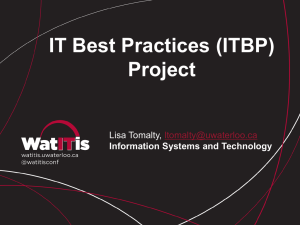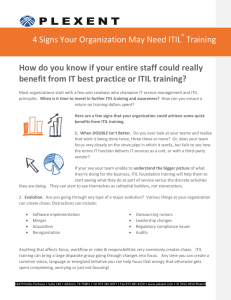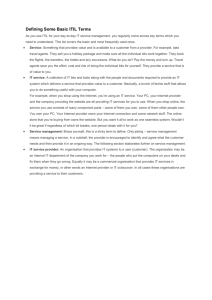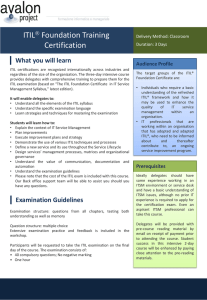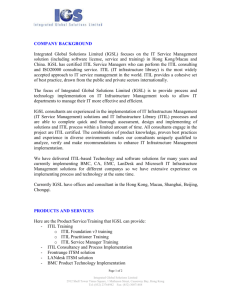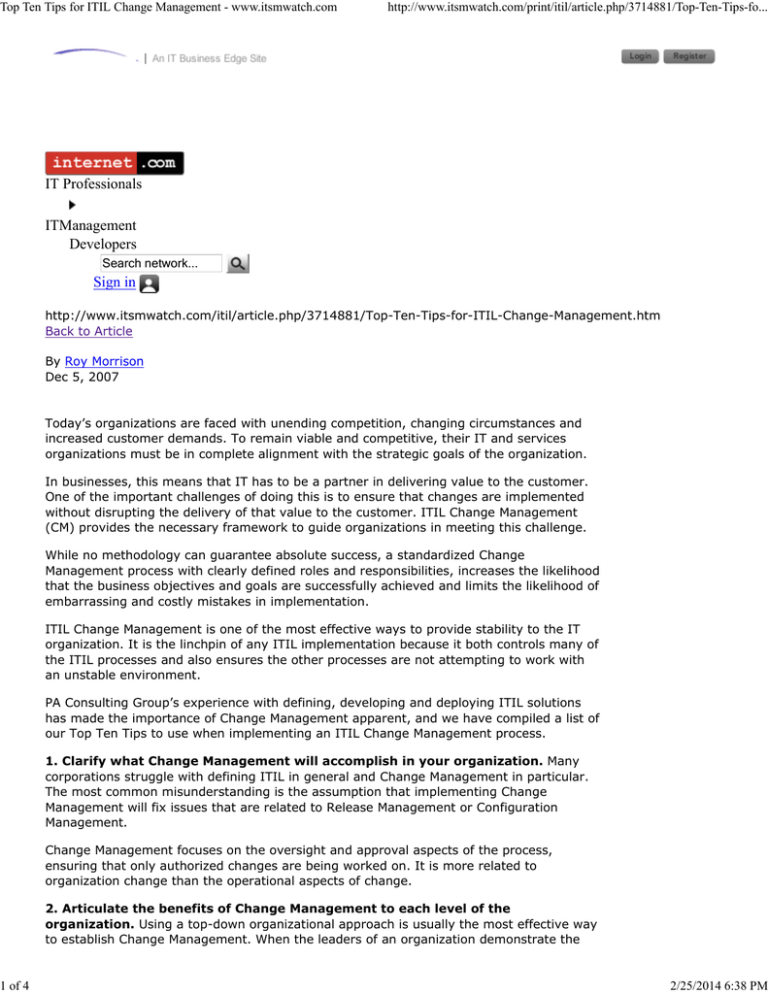
Top Ten Tips for ITIL Change Management - www.itsmwatch.com
1 of 4
http://www.itsmwatch.com/print/itil/article.php/3714881/Top-Ten-Tips-fo...
IT Professionals
ITManagement
Developers
Search network...
Sign in
http://www.itsmwatch.com/itil/article.php/3714881/Top-Ten-Tips-for-ITIL-Change-Management.htm
Back to Article
By Roy Morrison
Dec 5, 2007
Today’s organizations are faced with unending competition, changing circumstances and
increased customer demands. To remain viable and competitive, their IT and services
organizations must be in complete alignment with the strategic goals of the organization.
In businesses, this means that IT has to be a partner in delivering value to the customer.
One of the important challenges of doing this is to ensure that changes are implemented
without disrupting the delivery of that value to the customer. ITIL Change Management
(CM) provides the necessary framework to guide organizations in meeting this challenge.
While no methodology can guarantee absolute success, a standardized Change
Management process with clearly defined roles and responsibilities, increases the likelihood
that the business objectives and goals are successfully achieved and limits the likelihood of
embarrassing and costly mistakes in implementation.
ITIL Change Management is one of the most effective ways to provide stability to the IT
organization. It is the linchpin of any ITIL implementation because it both controls many of
the ITIL processes and also ensures the other processes are not attempting to work with
an unstable environment.
PA Consulting Group’s experience with defining, developing and deploying ITIL solutions
has made the importance of Change Management apparent, and we have compiled a list of
our Top Ten Tips to use when implementing an ITIL Change Management process.
1. Clarify what Change Management will accomplish in your organization. Many
corporations struggle with defining ITIL in general and Change Management in particular.
The most common misunderstanding is the assumption that implementing Change
Management will fix issues that are related to Release Management or Configuration
Management.
Change Management focuses on the oversight and approval aspects of the process,
ensuring that only authorized changes are being worked on. It is more related to
organization change than the operational aspects of change.
2. Articulate the benefits of Change Management to each level of the
organization. Using a top-down organizational approach is usually the most effective way
to establish Change Management. When the leaders of an organization demonstrate the
2/25/2014 6:38 PM
Top Ten Tips for ITIL Change Management - www.itsmwatch.com
2 of 4
http://www.itsmwatch.com/print/itil/article.php/3714881/Top-Ten-Tips-fo...
commitment and participation to implement a Change Management program, the better
the chance for success.
Getting buy-in at all levels is critical to the success of the program. The first step to
achieving a successful buy-in is identifying all stakeholder groups that are affected by such
an implementation.
Stakeholders need to understand the benefits on a personal and organizational level
(What’s in it for me?). Clearly defining and presenting to each stakeholder what those
benefits will be, and conversely, establishing and enforcing policies that address the
penalties and repercussions for bypassing the process is essential. Finally, to ensure buy-in
and understanding among everyone, be sure to communicate the same message to
everyone involved as to what those policies will cover.
3. Define what a Change is. The most important concept to convey is that everything in
the IT world can have a change element to it. Nothing should fly under the radar.
All Installs, Moves, Adds and Changes (IMAC’s) to the infrastructure, and any software
changes should fall under the control of Change Management. Even the most seemingly
innocuous changes can cause major disruptions if no one knows about them. This can be
especially true if you are implementing Change Management in an immature,
silo-structured organization.
4. Establish clear roles and responsibilities for the Change Advisory Board (CAB),
Change Manager, and Change Authority. Creating an Executive Committee for the CAB
is a good way to keep the executives engaged in the process without subjecting them to
the low level details that change management sometimes involves. Having executive
sponsorship increases your leverage when encountering parties resistant to changing the
status quo.
An effective and successful Change Manager is one who proactively ensures that the right
resources, both technical and business, attend the CAB and present viable, justifiable
changes. The Change Manager can be the final arbiter in resolving disputes over
classifications and prioritizations. (Some organizations use the Executive Committee for
issue resolution).
Ensure that the Change Authorities who are representing changes to the CAB are
well-informed and can speak to their items when challenged. Their role is to present the
business case, the impact analysis, the resource plan and execution plan for each change.
The CAB is not just an IT operation. A successful CAB will have a wide rotating mix of
participants from the IT, Operations and Business groups. Embrace the flexibility that the
CAB offers by limiting the standing participants and ensuring only those resources that can
add value to the discussions are invited to the meetings.
5. Create standardized processes and timeframes to support Change
Management. Defining processes and timeframes up front around Major, Minor and
Emergency changes will assist in managing client expectations as to when, and how,
changes will be delivered.
Getting the senior members of the Change Advisory Board (CAB) to sign off on the criteria
is essential to reducing the noise level.
Define the boundaries around priorities and hold to them. By having standard change
processes understood, there will be fewer circumventions of the system.
If your Change Management scope is significant, and incorporates IMAC’s as suggested
above, there needs to be a means of expediting the process to overcome the bureaucracy
that may prevail. Designing and implementing a standard change model for those changes
where the risk level is already well understood, allows for such expediency.
6. Establish and Stabilize the Change Management Process before introducing
2/25/2014 6:38 PM
Top Ten Tips for ITIL Change Management - www.itsmwatch.com
3 of 4
http://www.itsmwatch.com/print/itil/article.php/3714881/Top-Ten-Tips-fo...
tools. In theory, it seems logical to buy a tool that can guide your change management
implementation and utilize it as a key component of your change program. In practice, this
approach is rarely effective. Introducing new processes, making them more efficient and
finalizing them will lay the groundwork for defining the requirements for a tool selection.
You can then better evaluate a tool fit for your purposes instead of getting lost in the
various options that most tools present.
7. Define Key Performance Indicators (KPI) and Critical Success Factors (CSF)
that highlight the improvements that Change Management brings to the organization.
Bring metrics to Senior Management’s attention on a regular basis showing how CM is
benefiting the organization.
Sample CSF’s should reflect that CM is:
A repeatable process that can make changes quickly and accurately
Protecting the integrity of the service when making those changes
Delivering process efficiency and effectiveness
Sample KPI’s should be established around:
Reduction of unauthorized changes
Reduction in change related outages
Reduction in emergency changes
Actual cost of a change vs. planned (budgeted) cost
8. Ensure back-out plans are documented and realistic. Although no one ever
intentionally introduces defects into the production environment, it is a fact of life that
problems will sometimes arise as a result of new submissions. To combat these instances,
there must be a robust contingency plan in place to minimize the amount and length of
production outages. Ensuring that the Release Management team comes prepared to the
CAB with both their implementation plan and back-out strategy is an essential check-point
for the Change Manager.
9. Accentuate the positive by building on successes and leveraging lessons
learned. Discussing lessons learned, whether good or bad, is important for everyone
involved to better prepare for the next instance.
While it is important to correct bad behaviors after a release, it is just as important to
highlight what went well. Showcase success stories and integrate lessons learned into
plans for further roll-outs.
10. Use the Change Management Initiative to promote other ITIL processes. Many
organizations are only familiar with the Change Management component of ITIL.
· Use the success story from implementing Change Management to promote the benefits of
the other processes and how it will improve the overall performance of IT. Change
Management cannot be truly effective in isolation.
· When Release and Configuration Management processes are absent, consider combining
all three into a centralized function. The three processes have many close links to each
other and together can stabilize an organization’s production environment.
In summary, implementing Change Management is and should be viewed as a major
strategic undertaking. It is much more than a simple process roll-out. As a starting point,
organizations need to know where they stand in terms of ITIL maturity, where gaps exist,
and where they want to be.
Any ITIL implementation is a major change program that warrants a roadmap, a realistic
project plan and associated communications to achieve the desired outcomes. It also
requires training of the support organization as well as the users receiving the service on
new processes and procedures. Piloting the new processes or performing dry runs will
furthermore ensure smooth transition and higher effectiveness.
2/25/2014 6:38 PM
Top Ten Tips for ITIL Change Management - www.itsmwatch.com
4 of 4
http://www.itsmwatch.com/print/itil/article.php/3714881/Top-Ten-Tips-fo...
Using items such as these Top Ten Tips to aid understanding throughout the support
organization is a good starting point for design and deployment of an ITIL-based Change
Management Process. In the end, implementing change management is a key step in
establishing the stability you need to make your other ITIL processes and your
organization more successful.
Roy Morrison, a consultant in PA Consulting Group’s IT Consulting practice, has more than
20 years of experience in Sourcing and Service Management. He is also ITIL Foundation
Certified and serves a specialist in Change Management and Release Management, which
he has successfully implemented on a global basis. The author would like to thank Doug
McMahon, Alan Houghton, Michael Latchford, and Glen Willis for their contributions to this
article.
Sitemap | Contact Us
Property of Quinstreet Enterprise.
Terms of Service | Licensing & Reprints | About Us | Privacy Policy | Advertise
Copyright 2014 QuinStreet Inc. All Rights Reserved.
2/25/2014 6:38 PM


